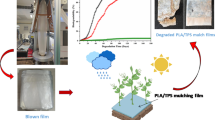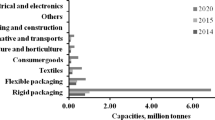Abstract
Biodegradable films of chia by-products (mucilage and protein-rich fraction (PF)) incorporated with clove essential oil (CEO) were obtained and characterized. The effects of polymer concentration (PC; 1.0–3.0 %, w/v) and CEO concentration (0.1–1.0 %, v/v) were evaluated as well as the pH (7–10), using a 23 factorial design with four central points. The films exhibited moisture values between 11.6 and 52.1 % (d.b.), which decreased (p < 0.05) with increasing PC and CEO. The thickness of the films increased (p < 0.05) with increasing PC. PC and pH influenced (p < 0.05) the lightness (L) and variation in color between red and green (a). The orientation of the color to yellow-blue hues (b) decreased significantly (p < 0.05) with increasing PC. Transparency was significantly lower and higher (p < 0.05) than PC and CEO, respectively. The film surface morphology was evaluated using atomic force miscrocope images, and thermogravimetric analysis (TGA) was performed to study the thermal stability of the films. The displacement and tensile strength were significantly lower (p < 0.05) at higher concentrations of CEO, this variable being the only one with a significant effect. The chemical composition of the films was confirmed utilizing Fourier transform infrared (FTIR) spectroscopy. The proportion of CEO added to the films had a significant influence on antimicrobial activity, inhibiting the growth of both Escherichia coli and Staphylococcus aureus.





Similar content being viewed by others
References
AOAC. (1997). Official methods of analysis. Arlington: AOAC.
Arora, D. S., & Kaur, J. (1999). Antimicrobial activity of spices. International Journal of Antimicrobial Agriculture, 12, 257–62.
Appendini, P., & Hotchkiss, J. H. (2002). Review of antimicrobial food packaging. Innovative Food Science and Emerging Technologies, 3(2), 113–126.
Arvanitoyannis, I. S., Nakayama, A., & Aiba, S. (1998). Chitosan and gelatin based edible films: state diagrams, mechanical and permeation properties. Carbohydrate Polymers, 37, 371–382.
ASTM. (2000). D882—standard test method for tensile properties of thin plastic sheeting. In Annual Book of ASTM Standard (pp. 160–168). Philadelphia.
Azero, E., & Andrade, C. (2006). Characterisation of Prosopis juliflora seed gum and the effect of its addition to k-carrageenan systems. Journal of Brazilian Chemical Society, 17(5), 844–850.
Burt, S. A. (2004). Essential oils: their antibacterial properties and potential applications in foods: a review. International Journal of Food Microbiology, 94, 223–253.
Carneiro-da-Cunha, M. G., Cerqueira, M. A., Souza, B. W. S., Souza, M. P., Teixeira, J. A., & Vicente, A. A. (2009). Physical properties of edible coatings and films made with a polysaccharide from Anacardium occidentale L. Journal of Food Engineering, 95(3), 379–385.
Cutter, C. (1999). The effectiveness of triclosan incorporated plastic against bacteria on beef surfaces. Journal of Food Protection, 62, 474–479.
Deans, S. G., & Ritchie, G. (1987). Antibacterial properties of plant essential oils. International Journal of Food Microbiology, 5, 165–180.
Delaquis, P. J., Stanich, K., Girard, B., & Mazza, G. (2002). Antimicrobial activity of individual and mixed fractions of dill, cilantro, coriander and eucalyptus essential oils. International Journal of Food Microbiology, 74, 101–9.
Diab, T., Biliaderis, C. G., Gerasopoulos, D., & Sfakiotakis, E. (2001). Physicochemical properties and application of pullulan edible films and coatings in fruit preservation. Journal of the Science of Food and Agriculture, 81(10), 988–1000.
Du, W. X., Olsen, C. W., Avena-Bustillos, R. J., McHugh, T. H., Levin, C. E., & Friedman, M. (2009). Effects of allspice, cinnamon and clove bud essential oils in apple films on antimicrobial activities against Escherichia coli O157:H7, Salmonella enterica, and Listeria monocytogenes. Journal of Food Science, 74(7), 372–378.
Espino-Díaz, M., Ornelas-Paz, J., Martínez-Téllez, M. A., Santillán, C., Barbosa-Cánovas, G. V., Zamudio-Flores, P. B., & Olivas, G. I. (2010). Development and characterization of edible films based on mucilage of Opuntiaficus-indica (L.). Journal of Food Science, 75(6), 347–352.
Gennadios, A., McHugh, T.H., Weller, C.L., Krochta, J.M. (1994). Edible coating and films based on proteins. In: J. M. Krochta, E. A. Baldwin, M. O. Nisperos-Carriedo. (Eds.) Edible coatings and films to improve food quality (pp. 201–277). Technomic Lancaster, PA: Publishing Co.
Giancone, T., Torrieri, L., Di Pierro, P., Cavella, S., Giosafatto, C. V. L., & Masi, P. (2011). Effect of surface density on the engineering properties of high methoxyl pectin-based edible films. Food and Bioprocess Technology, 4(7), 1228–1236.
Gontard, N., Guilbert, S., & Cuq, J. L. (1993). Water and glycerol as plasticizers affect mechanical and water vapor barrier properties of an edible wheat gluten film. Journal of Food Science, 58(1), 206–211.
Han, J. H., & Floros, J. D. (1997). Casting antimicrobial packaging films and measuring their physical properties and antimicrobial activity. Journal of Plastic Films and Sheeting, 13, 287–298.
Hentry, H. S., Mittleman, M., & McCrohan, P. R. (1990). Introducción de la Chía y la goma de tragacanto en los Estados Unidos. In J. Janick & J. E. Simon (Eds.), Avances en Cosechas Nuevas (pp. 252–256). Portland, Ohio: Prensa de la Madera.
Jouki, M., Yazdi, F. T., Mortazavi, S. A., & Koocheki, A. (2014). Quince seed mucilage films incorporated with oregano essential oil: physical, thermal, barrier, antioxidant and antibacterial properties. Food Hydrocolloids, 36, 9–19.
Khazaei, N., Esmaiili, M., Djomeh, Z. E., Ghasemlou, M., & Jouki, M. (2014). Characterization of new biodegradable edible film made from basil seed (Ocimum basilicum L.) gum. Carbohydrate Polymers, 102, 199–206.
Lin, K. Y., Daniel, J. R., & Whistler, R. L. (1994). Structure of chia seed polysaccharide exudate. Carbohydrate Polymers, 23(1), 13–18.
Malathi, A. N., Santhosh, K. S., & Nidoni, U. (2014). Recent trends of biodegradable polymer: biodegradable films for food packaging and application of nanotechnology in biodegradable food packaging. Current Trends in Technology and Science, 3(2), 73–79.
Mali, S., Grossmann, M. V. E., Garcıa, M. A., Martino, M. M., & Zaritzky, N. E. (2004). Barrier, mechanical and optical properties of plasticized yam starch films. Carbohydrate Polymers, 56, 129–135.
Martins, J. T., Cerqueira, M. A., Bourbon, A. I., Pinheiro, A. C., Bartolomeu, W. S., Souza, B. W. S., & Vicente, A. A. (2012). Synergistic effects between k-carrageenan and locust bean gum on physicochemical properties of edible films made thereof. Food Hydrocolloids, 29, 280.
Mathew, A. P., & Dufresne, A. (2002). Morphological investigation of nanocomposites from sorbitol plasticized starch and tunicin whiskers. Biomacromolecule, 3, 609–617.
Muñoz-Hernández, L. (2012). Mucilage from chia seeds (Salvia hispanica): microestructure, physico-chemical characterization and applications in food industry. Doctor degree thesis. Escuela de Ingeniería, Pontificia Universidad Católica de Chile
Nonsee, K., Supitchaya, C., & Thawien, W. (2011). Antimicrobial activity and the properties of edible hydroxypropyl methylcellulose based films incorporated with encapsulated clove (Eugenia caryophyllata Thunb.) oil. International Food Research Journal, 18(4), 1531–1541.
Nur-Hanani, Z. A., Beatty, E., Roos, Y. H., Mick, A., Morris, M. A., & Kerry, J. P. (2013). Development and characterization of biodegradable composite films based on gelatin derived from beef, pork and fish sources. Foods, 2, 1–17.
Osés, J., Fabregat-Vázquez, M., Pedroza-Islas, R., Tomás, S. A., Cruz-Orea, A., & Maté, J. I. (2009). Development and characterization of composite edible films based on whey protein isolate and mesquite gum. Journal of Food Engineering, 92(1), 56–62.
Otto, T., Baik, B., & Czuchajowska, Z. (1997). Wet fractionation of garbanzo bean and pea flours. Cereal Chemistry, 74, 141–146.
Perez-Gago, M. B., & Krochta, J. M. (2001). Denaturation time and temperature effects on solubility, tensile properties, and oxygen permeability of whey protein edible films. Journal of Food Science, 66(5), 705–709.
Pranoto, Y., Salokhe, V. M., & Rakshit, S. K. (2005). Physical and antibacterial properties of alginate-based edible film incorporated with garlic oil. Food Research International, 38, 267–272.
Quintavalla, S., & Vicini, L. (2002). Antimicrobial food packing in meat industry. Meat Science, 62(3), 373–380.
Raybaudi-Massilia, R. M., Mosqueda-Melgar, J., & Martín-Belloso, O. (2008). Edible alginate-based coating as carrier of antimicrobials to improve shelf-life and safety of fresh-cut melon. International Journal of Food Microbiology, 121(3), 313–327.
Raybaudi-Massilia, R. M., Mosqueda-Melgar, J., & Martin-Belloso, O. (2006). Antibacterial activity of essential oils on Salmonella enteritis, Escherichia coli and Listeria innocua in fruit juices. Journal of Food Protection, 69, 1579–1586.
Rhim, J. W., Wu, Y., Weller, C. L., & Schnepf, M. (1999). Physical characteristics of composite film of soy protein isolate and propylenglycol alginate. Journal of Food Science, 64(1), 149–152.
Romero-Bastida, C. A., Zamudio-Flores, P. B., & Bello-Pérez, L. A. (2011). Antimicrobianos en películas de almidón oxidado de plátano: efecto sobre la actividad antibacteriana, microestructura, propiedades mecánicas y de barrera. Revista Mexicana de Ingenieria Quimica, 10(3), 445–453.
Seyedi, S., Koocheki, A., Mohebbi, M., & Zahedi, Y. (2014). Lepidium perfoliatum seed gum: a new source of carbohydrate to make a biodegradable film. Carbohydrate Polymers, 101, 349–358.
Shiku, Y., Hamaguchi, P. Y., & Tanaka, M. (2003). Effect of pH on the preparation of edible films based on fish myofibrillar proteins. Fish Science, 69, 1026–1032.
Stuchell, Y., & Krichta, J. (1994). Enzymatic treatments and thermal effects on edible soy protein films. Journal of Food Science, 59, 1332–1357.
Tepe, B., Daferera, D., Sokmen, M., Polissiou, M., & Sokmen, A. (2004). In vitro antimicrobial and antioxidant activities of the essential oils and various extracts of Thymus eigii M. Journal of Agriculture and Food Chemistry, 52, 1132–1137.
Valgas, C., Machado de Souza, S., Elza, F. A., Smânia, E. F. A., & Smânia, A. J. (2007). Screening methods to determine antibacterial activity of natural products. Brazilian Journal of Microbiology, 38, 369–380.
Vásconeza, M. B., Flores, S. K., Campos, C. A., Alvarado, J., & Gerschenson, L. N. (2009). Antimicrobial activity and physical properties of chitosan–tapioca starch based edible films and coatings. Food Research International, 42(7), 762–769.
Wang, L.-H., & Sung, W. C. (2011). Rapid evaluation and quantitative analysis of eugenol derivatives in essential oils and cosmetic formulations on human skin using attenuated total reflectance-infrared spectroscopy. Spectroscopy, 26, 43–52.
Acknowledgments
This research forms part of Project 189741 “Aspectos tecnológico-funcionales de subproductos de chía (Salvia hispánica L.) aplicables al desarrollo de alimentos,” financed by the Consejo Nacional de Ciencia y Tecnología (CONACYT), Universidad Autónoma de Yucatán–Facultad de Ingeniería Química (UADY), México and Consejo Nacional de Investigaciones Científicas y Técnicas (CONICET, PIP 1735), Universidad Nacional de La Plata (UNLP, 11/X610), and Universidad Nacional del Centro de la Provincia de Buenos Aires (UNCPBA), Argentina.
Author information
Authors and Affiliations
Corresponding author
Rights and permissions
About this article
Cite this article
Capitani, M.I., Matus-Basto, A., Ruiz-Ruiz, J.C. et al. Characterization of Biodegradable Films Based on Salvia hispanica L. Protein and Mucilage. Food Bioprocess Technol 9, 1276–1286 (2016). https://doi.org/10.1007/s11947-016-1717-y
Received:
Accepted:
Published:
Issue Date:
DOI: https://doi.org/10.1007/s11947-016-1717-y




